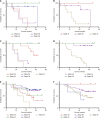Subclassification scheme for adenocarcinomas of the esophagogastric junction and prognostic analysis based on clinicopathological features
- PMID: 40235906
- PMCID: PMC11995350
- DOI: 10.4251/wjgo.v17.i4.103455
Subclassification scheme for adenocarcinomas of the esophagogastric junction and prognostic analysis based on clinicopathological features
Abstract
Background: Adenocarcinoma of the esophagogastric junction (AEG) has distinct malignant features compared with other esophageal and gastric cancers. Its management is controversial and largely influenced by tumor location and esophageal involvement. Hence, understanding the clinicopathological characteristics and prognosis of AEG is essential for optimizing treatment strategies.
Aim: To evaluate the prognosis and clinicopathological features of patients with AEG, providing insights for management strategies.
Methods: This retrospective study analyzed cases with AEG admitted between January 2016 and December 2017. Patients meeting the inclusion criteria were categorized into three groups: Type E [tumors whose center was located within 5 cm above the esophagogastric junction (EGJ)]; Type Eg (tumors whose center was situated within 2 cm below the EGJ), with a 2-cm esophageal invasion; Type Ge (tumors whose center was situated within 2 cm below the EGJ, with an esophageal invasion of < 2 cm, based on tumor location and esophageal involvement. Then, clinicopathological characteristics and survival outcomes of the groups were compared to evaluate the predictive value of the American Joint Committee on Cancer/International Alliance against Cancer 8th edition gastric cancer and esophageal adenocarcinoma staging systems. Statistical analysis included survival analysis and Cox regression to assess prognostic factors.
Results: Totally, 153 patients with AEG were included (median follow up: 41.1 months; 22, 31, and 100 patients from type E, Eg, and Ge, respectively), with significant differences in maximum tumor length, esophageal involvement length, tumor type, pathology, differentiation, depth of invasion, and lymph node metastasis between the groups (P < 0.05). Lymph node metastasis rates at stations 1, 2, 3, and 7 were lower in type E than in Eg and Ge (P < 0.05). Survival rates for type E (45.5%) were significantly lower than those for Eg (48.4%) and Ge (73.0%) (P = 0.001). Type E tumors, vascular infiltration, T3-T4 invasion depth, and lymph node metastasis, were identified as independent prognostic factors (P < 0.05). The gastric cancer staging system outperformed the esophageal adenocarcinoma system for type Ge tumors.
Conclusion: Clinicopathological characteristics and prognoses varied between the AEG groups, with type E demonstrating distinct features. The gastric cancer staging system more accurately predicted type Ge AEG prognosis, guiding clinical decision-making.
Keywords: Adenocarcinoma of esophagogastric junction; Prognosis; Risk factors; Siewert classification; Survival rate.
©The Author(s) 2025. Published by Baishideng Publishing Group Inc. All rights reserved.
Conflict of interest statement
Conflict-of-interest statement: The authors declare that they have no conflict of interest.
Figures



Similar articles
-
[Evaluation of the value of 7th editions of UICC-AJCC esophageal and gastric cancer TNM staging systems for prognostic prediction of adenocarcinoma of esophagogastric junction (Siewert type II)].Zhonghua Zhong Liu Za Zhi. 2014 Dec 23;36(12):916-21. doi: 10.3760/cma.j.issn.0253-3766.2014.12.008. Zhonghua Zhong Liu Za Zhi. 2014. PMID: 25623766 Chinese.
-
Clinicopathological features and prognostic factors of adenocarcinoma of the esophagogastric junction according to Siewert classification: experiences at a single institution in Japan.Ann Surg Oncol. 2012 Feb;19(2):677-83. doi: 10.1245/s10434-011-1983-x. Epub 2011 Aug 6. Ann Surg Oncol. 2012. PMID: 21822549 Clinical Trial.
-
Clinicopathological characteristics and optimal management for esophagogastric junctional cancer; a single center retrospective cohort study.J Exp Clin Cancer Res. 2013 Jan 7;32(1):2. doi: 10.1186/1756-9966-32-2. J Exp Clin Cancer Res. 2013. PMID: 23289488 Free PMC article.
-
Esophagogastric junction adenocarcinomas: individualization of resection with special considerations for Siewert type II, and Nishi types EG, E=G and GE cancers.Gastric Cancer. 2020 Jan;23(1):3-9. doi: 10.1007/s10120-019-01022-x. Epub 2019 Nov 6. Gastric Cancer. 2020. PMID: 31691875 Review.
-
Treatment results of adenocarcinoma of the gastroesophageal junction.Hepatogastroenterology. 2008 Mar-Apr;55(82-83):475-81. Hepatogastroenterology. 2008. PMID: 18613391 Review.
References
-
- Kusano C, Gotoda T, Khor CJ, Katai H, Kato H, Taniguchi H, Shimoda T. Changing trends in the proportion of adenocarcinoma of the esophagogastric junction in a large tertiary referral center in Japan. J Gastroenterol Hepatol. 2008;23:1662–1665. - PubMed
-
- Lu YK, Li YM, Gu YZ. Cancer of esophagus and esophagogastric junction: analysis of results of 1,025 resections after 5 to 20 years. Ann Thorac Surg. 1987;43:176–181. - PubMed
-
- Kauppila JH, Lagergren J. The surgical management of esophago-gastric junctional cancer. Surg Oncol. 2016;25:394–400. - PubMed
LinkOut - more resources
Full Text Sources

